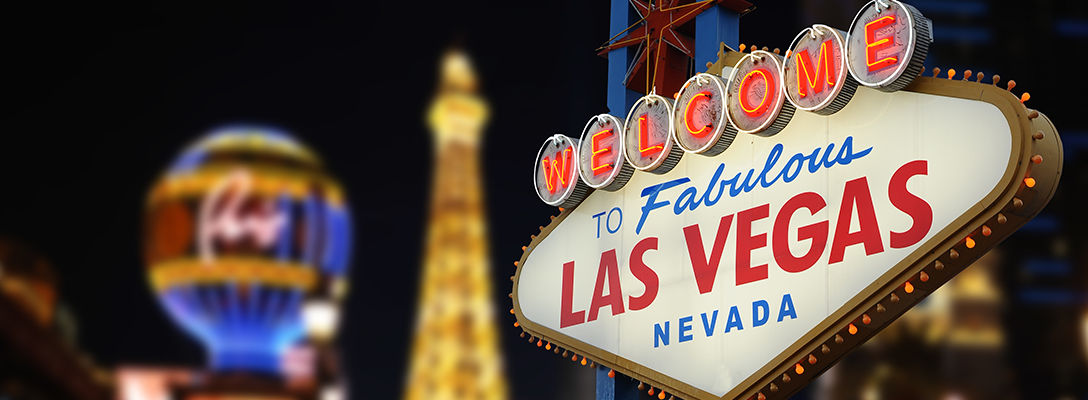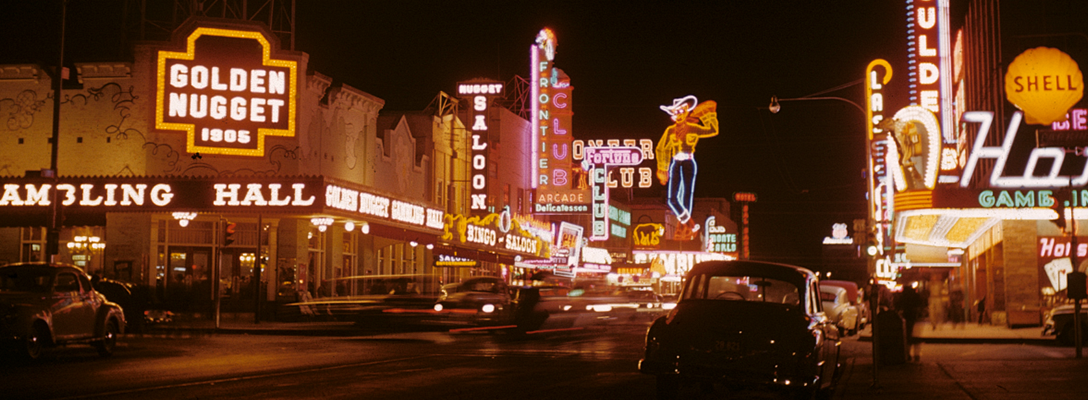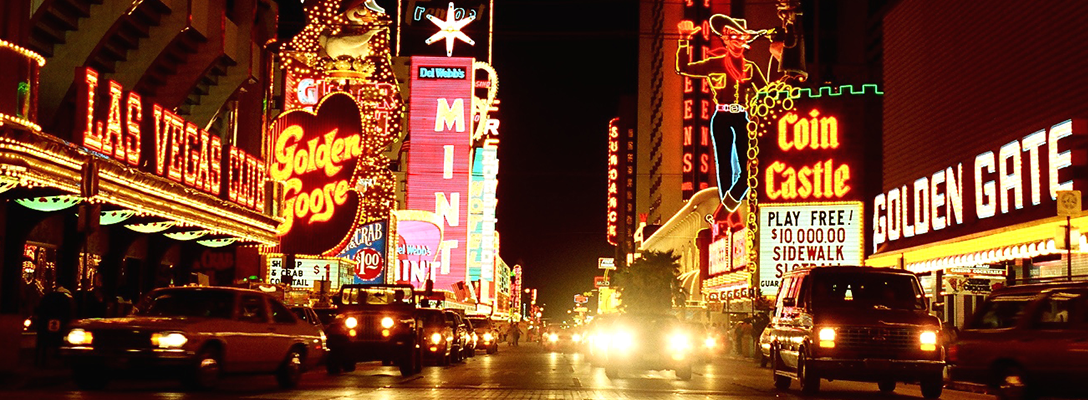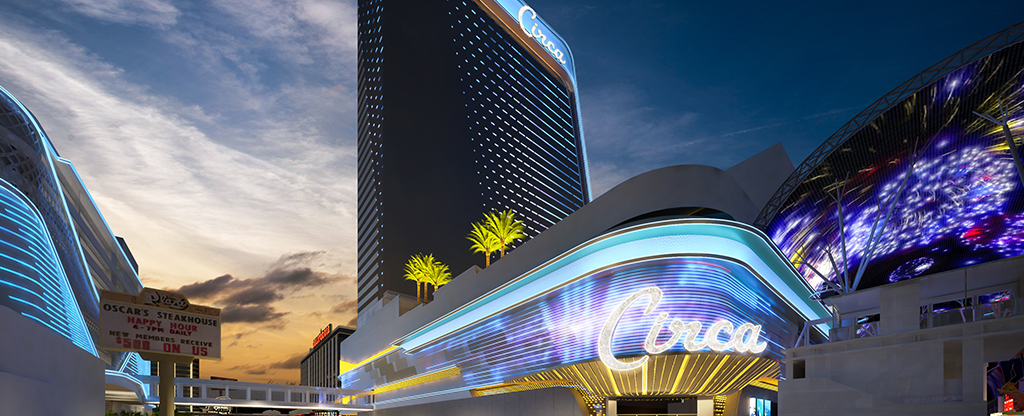Glitter Gulch to Now: The History of Neon in Las Vegas

There is no questioning that neon had quite the impact on the growth of Las Vegas. What was once a small, desert town with great gambling grew into a dazzling city of neon lights and a gambler’s paradise. Neon brought to Vegas the symbolism of the modern age where you were surrounded by glamour, entertainment, spectacular showmanship, and a great sense of freedom. The glow of neon was also the glow of hope and prosperity in Glitter Gulch, Las Vegas.
As we raise Circa’s neon sign, we nod to the glamorous and interesting history of Las Vegas and all of its neon glory. Learn more about Glitter Gulch, Vegas Vic, and Vegas Vickie and how neon shaped (and illuminated) Vegas!
The History of Neon Lights
The Creation of Neon
The discovery of neon in 1898 by British scientists William Ramsay and Morris W. Travers included the observation of a brilliant red glow in Geissler tubes, or sealed glass tubes containing “rarefied” gas. Travers wrote, “the blaze of crimson light from the tube told its own story and was a sight to dwell upon and never forget.”
Following neon’s discovery, neon tubes were used as scientific instruments and novelties. It wasn’t until 1902 when Georges Claude began producing industrial quantities of neon and realized the benefit of neon in advertising. In 1912, the first neon sign was installed outside a barbershop in Paris to attract customers.
Stateside Beginnings in California
While neon lights are practically synonymous with Las Vegas, Los Angeles was actually the first city to be illuminated by these new lights in the 1920s. At that time, Las Vegas was still just a blip in the desert, but LA was a thriving city being fueled by modern businesses. The first neon signs in the US were installed outside California’s first Packard dealership in 1923. The signs were an instant hit and even caused traffic jams as drivers stopped to marvel at the glowing lights.

Alt Text: Glitter Gulch, Las Vegas Neon Lights
Glitter Gulch, Las Vegas
Though neon signs first appeared in Vegas in 1929, in 1931 an event occurred that paved the way for Las Vegas to become the city of neon – construction of Hoover Dam began on the Colorado River. The creation of Hoover Dam and its electricity allowed Las Vegas to become the City of Neon Lights. The electricity provided by the new dam helped transform Las Vegas from a sleepy frontier town into the tourist attraction it is today. Neon signs had proven that they could draw people in, so when Las Vegas was looking for a way to get people to the city, neon signs seemed like the perfect solution.
After Hoover Dam was built in 1935, Las Vegas’ neon-lit main thoroughfare, Fremont Street, was quickly catching neon fever and the glowing signs began illuminating storefronts and businesses. Soon casinos, diners, and department stores all had neon. What set Vegas apart from the rest of America at the time was the sheer number of neon signs. Due to the abundant electricity from the dam, neon in Las Vegas turned night into day, earning Downtown Las Vegas the name of Glitter Gulch in the 1940s.
The Rise and Fall of Neon in Vegas
As the city continued to grow and showcase experimental architecture that simply wasn’t being practiced anywhere else in the world, neon signs became their own form of decoration. They weren’t just signs, but essential parts of some of Las Vegas’s most iconic buildings, including the Stardust, Binion’s Horseshoe, the Golden Nugget, and Caesars Palace.
Over the next few decades, competition drove casinos to build more luxurious buildings and cover them in even more creative and jaw-dropping neon signs. The neon lights served as great advertising tools and they helped light up the streets of Las Vegas so gamblers could continue well into the morning hours.
The 1960s were the heyday of neon signs in Vegas, and the city was practically a shrine to neon. It was home to five of the world’s tallest electric signs. By the late 60s, plastic signs were all the rage because they offered a cheaper alternative and the city was looking for new and creative ways to market itself. New developers looked at neon as a sign of the past and they were looking toward the future with more modern design aesthetics.

Famous Las Vegas Neon Signs
Vegas Vic
One of the most famous neon signs on Fremont Street is the endearing Las Vegas landmark from 1951, Vegas Vic. The 90-foot-tall cowboy in front of the Pioneer Club featured a moveable arm beckoning to passing motorists and a speaker welcoming pedestrians with a friendly “Howdy Podner!” While the Pioneer Club no longer operates as a casino, the sign can still be found at 25 E Fremont Street, his home since 1951.
Vegas Vickie
Since 1980, Vickie has reigned over Fremont Street, kicking one leg in the air directly across the street from Vegas Vic. In 1994, the two were even “married” in true Vegas fashion to celebrate the Fremont Street Experience opening. In 2017, Vickie was retired from the Vegas skyline. Thankfully, she has a new home and will live in Circa Resort & Casino, greeting guests with her dazzling smile within the Circa Las Vegas hotel lobby.
Welcome to Fabulous Las Vegas Sign
We couldn’t talk about neon in Las Vegas without mentioning the famous Welcome to Fabulous Las Vegas sign! Designed by Betty Willis, an employee of Western Neon, and built in 1959, the sign has been a welcome landmark for those entering Vegas. It has since been listed in the State Register of Historic Places. The sign is located in the median at 5100 Las Vegas Boulevard South, where some consider the sign to be the official southern end of the Las Vegas Strip.

Neon in Las Vegas Today
While elaborate neon signs may no longer define the strip, these lights have played an important role in the history of the city. In 1996, the Neon Museum was founded and it now hosts hundreds of thousands of visitors every year. The collection showcases design trends and technological advances through time and allows visitors to experience famous signs. Visitors can wander the 2.62 acres of outdoor displays or register for a guided tour. It is the perfect place to learn about the history of Las Vegas and get up close to some truly impressive signs that helped to shape the city.
Today, Vegas continues to push the limits of design and technology. It is truly an innovation hub where big dreams are turned into reality in order to attract and impress customers. The best in everything from architecture, software, and design are on full display in the city. Now both Downtown Las Vegas and the Strip rely on providing entertainment to attract customers.
To compete with the Strip, Downtown Las Vegas ushered in the future of signage with the 90 ft. tall canopy that features high-resolution imagery and state-of-the-art, concert-quality sound – the Viva Vision Light Show at the Fremont Street Experience. Meanwhile, on the Strip the sidewalk spectacles of the megaresorts (including the architecture of many of them) are the new attractions, not the signs. All this means that the future of signage both in downtown Las Vegas and on the Strip lies in entertainment design that makes neon signs unneeded.
However, at Circa Las Vegas Resort & Casino we aim to honor the golden ages of Vegas circa 1940, 1980, 2020 and beyond, which includes honoring the history of neon in Las Vegas. Rooted in the neon glow of the past, we celebrate living large in the now, and keep our eyes wide open to the future. Stop by for some vintage neon Las Vegas vibes, say hi to Vegas Vickie, and make some history of your own.
